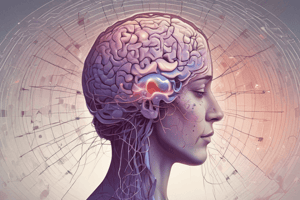Podcast
Questions and Answers
What is the primary characteristic of epilepsy?
What is the primary characteristic of epilepsy?
- Trauma or infection causing seizures
- Involuntary spasmodic contractions of voluntary muscles
- Abnormal electrical activity in the nerve cells of the brain
- Excessive electrical activity of neurons in the cerebral cortex (correct)
What is the most common chronic neurologic illness?
What is the most common chronic neurologic illness?
- Multiple sclerosis
- Parkinson's disease
- Alzheimer's disease
- Epilepsy (correct)
What percentage of patients with epilepsy have normal EEGs?
What percentage of patients with epilepsy have normal EEGs?
- 80%
- 20%
- 50% (correct)
- 30%
What is the main difference between primary and secondary epilepsy?
What is the main difference between primary and secondary epilepsy?
What is a febrile seizure?
What is a febrile seizure?
What is status epilepticus?
What is status epilepticus?
What is the medication of choice for treating status epilepticus?
What is the medication of choice for treating status epilepticus?
What is the next step in treatment after controlling status epilepticus?
What is the next step in treatment after controlling status epilepticus?
What is the primary goal of antiepileptic drug therapy?
What is the primary goal of antiepileptic drug therapy?
What is the rationale for using single-drug therapy initially?
What is the rationale for using single-drug therapy initially?
What should be monitored individually for each patient?
What should be monitored individually for each patient?
What is the mechanism of action of antiepileptic drugs?
What is the mechanism of action of antiepileptic drugs?
What is the overall effect of antiepileptics on neurons?
What is the overall effect of antiepileptics on neurons?
What is the use of benzodiazepines in seizure treatment?
What is the use of benzodiazepines in seizure treatment?
What is the primary indication for antiepileptic drugs?
What is the primary indication for antiepileptic drugs?
What is the mechanism of action of some antiepileptics in terms of neurotransmitters?
What is the mechanism of action of some antiepileptics in terms of neurotransmitters?
Which of the following drugs is available for rectal administration when oral administration is not possible?
Which of the following drugs is available for rectal administration when oral administration is not possible?
What is the primary mechanism of action of carbamazepine in treating epilepsy?
What is the primary mechanism of action of carbamazepine in treating epilepsy?
What is a common adverse effect of gabapentin?
What is a common adverse effect of gabapentin?
What is the primary indication for phenobarbital?
What is the primary indication for phenobarbital?
Which of the following drugs is associated with autoinduction of hepatic enzymes?
Which of the following drugs is associated with autoinduction of hepatic enzymes?
What is a contraindication for phenobarbital?
What is a contraindication for phenobarbital?
Which of the following drugs is a chemical analogue of GABA?
Which of the following drugs is a chemical analogue of GABA?
What is the primary indication for phenytoin?
What is the primary indication for phenytoin?
What is one way phenytoin can interact with other medications?
What is one way phenytoin can interact with other medications?
What is a common adverse effect of long-term phenytoin therapy?
What is a common adverse effect of long-term phenytoin therapy?
What is a contraindication for valproic acid?
What is a contraindication for valproic acid?
What is a common adverse effect of valproic acid?
What is a common adverse effect of valproic acid?
What is a reason why phenytoin is highly effective?
What is a reason why phenytoin is highly effective?
What is a serious adverse effect of valproic acid?
What is a serious adverse effect of valproic acid?
Flashcards are hidden until you start studying
Study Notes
What is a Seizure?
- A seizure is a brief episode of abnormal electrical activity in the nerve cells of the brain.
- It may or may not lead to a convulsion.
What is Epilepsy?
- Epilepsy is a chronic, recurrent pattern of seizures.
- It results from excessive electrical activity of neurons located in the superficial area of the brain (cerebral cortex).
- It is the most common chronic neurologic illness.
Types of Epilepsy
- Primary (idiopathic) epilepsy: Epilepsy without an identifiable cause.
- Secondary epilepsy: Epilepsy has a distinct cause, such as trauma, infection, cerebrovascular disorder, or other illness.
Febrile Seizure
- Occurs in children aged 6 months to 5 years.
- Caused by fever.
- Children usually outgrow the tendency to have such seizures.
- Does not constitute a chronic illness.
Status Epilepticus
- Two or more seizures occur without recovery of full consciousness in between episodes.
- May be focal or primary generalized, convulsive or nonconvulsive.
- Life-threatening and requires emergency treatment.
- Therapy involves administering fast-acting medication, typically diazepam (the drug of choice).
- Once status epilepticus is controlled, long-term drug therapy is begun with other drugs, such as phenytoin, for the prevention of future seizures.
Antiepileptic Drugs
- Goal: to control or prevent seizures while maintaining a reasonable quality of life.
- In most cases, the therapeutic goal is to maximally reduce the incidence of seizures while minimizing drug-induced toxicity.
- Sometimes, a combination of drugs must be given to control the disorder.
- Single-drug therapy must fail before two-drug or multidrug therapy is attempted.
- Antiepileptic drugs should never be stopped abruptly unless a severe adverse effect occurs.
- Therapeutic drug monitoring of serum drug concentrations provides a useful guideline in assessing the effectiveness of therapy.
- Each patient should be monitored individually, and the dosages adjusted based on the individual case.
Mechanism of Action
- The exact mechanism of action of antiepileptic drugs is not known with certainty.
- Strong evidence indicates that they alter the movement of sodium, potassium, calcium, and magnesium.
- Regardless of mechanism, the overall effect is that antiepileptics stabilize neurons and keep them from becoming hyperexcited and generating excessive nerve impulses to adjacent neurons.
Indications
- Antiepileptic drugs are chiefly used for the long-term maintenance treatment of epilepsy.
- They are also useful for the acute treatment of convulsions and status epilepticus.
Drug Profiles
A. Benzodiazepines
- Bind to GABA inhibitory receptors to reduce firing rate.
- Most benzodiazepines are reserved for emergency or acute seizure treatment due to tolerance.
- Clonazepam and clobazam may be prescribed as adjunctive therapy for types of seizures.
- Diazepam is also available for rectal administration when oral administration is not possible.
B. Carbamazepine (Tegretol)
- Marketed in the late 1960s for the treatment of epilepsy in adults after its efficacy and safety for the treatment of trigeminal neuralgia were proved.
- Blocks sodium channels, thereby inhibiting the generation of repetitive action potentials in the epileptic focus and preventing their spread.
- Effective for treatment of focal seizures and, additionally, generalized tonic–clonic seizures, trigeminal neuralgia, and bipolar disorder.
- Associated with autoinduction of hepatic enzymes.
- Hyponatremia may be noted in some patients, especially the elderly, and may necessitate a change in medication.
C. Gabapentin
- Chemical analogue of GABA.
- Precise mechanism of action is not known.
- Indicated as an adjunct drug for the treatment of partial seizures and for prophylaxis of partial seizures.
- Effective as a single-drug therapy for the new-onset epilepsy.
- Also commonly used to treat neuropathic pain.
- Adverse effects include CNS and GI symptoms.
D. Phenobarbital
- Used primarily in the treatment of status epilepticus when other agents fail.
- Effective prophylactic drug for the control of febrile seizures.
- In developing countries, oral phenobarbital is often the drug of choice for routine seizure prophylaxis because of its lower cost compared with the newer drugs.
- Associated with physical dependence and withdrawal syndrome.
- Interacts with many drugs because it is a major liver enzyme inducer.
- Available in oral and injectable forms.
- Most common adverse effect is sedation.
- Contraindications include:
- Known drug allergy
- Liver or kidney impairment
- Respiratory illness
E. Phenytoin
- Primarily indicated for the management of tonic-clonic and partial seizures.
- Most often taken orally or given intravenously if needed.
- Contraindications include:
- Known drug allergy
- Heart conditions that involve bradycardia
- Most common adverse effects are:
- Lethargy
- Abnormal movements
- Mental confusion
- Long-term phenytoin therapy can cause:
- Gingival hyperplasia
- Acne
- Hirsutism
- Can interact with other medications for two reasons:
- First, it is highly bound to plasma proteins and competes with other highly protein-bound medications for binding sites.
- Second, it induces hepatic enzymes.
- Generally well tolerated, highly effective, and relatively inexpensive.
F. Valproic acid
- Used primarily in the treatment of generalized seizures.
- Also shown to be effective in controlling partial seizures.
- Main reason for drug interactions is protein binding and liver metabolism.
- Available in both oral and injectable forms.
- Most serious adverse effects are:
- Hepatotoxicity
- Pancreatitis
- Contraindications include:
- Known drug allergy
- Liver impairment
- Urea cycle disorders
- Common adverse effects include:
- Drowsiness
- GI disturbances (nausea, vomiting)
- Tremor
- Weight gain
- Transient hair loss
Studying That Suits You
Use AI to generate personalized quizzes and flashcards to suit your learning preferences.




